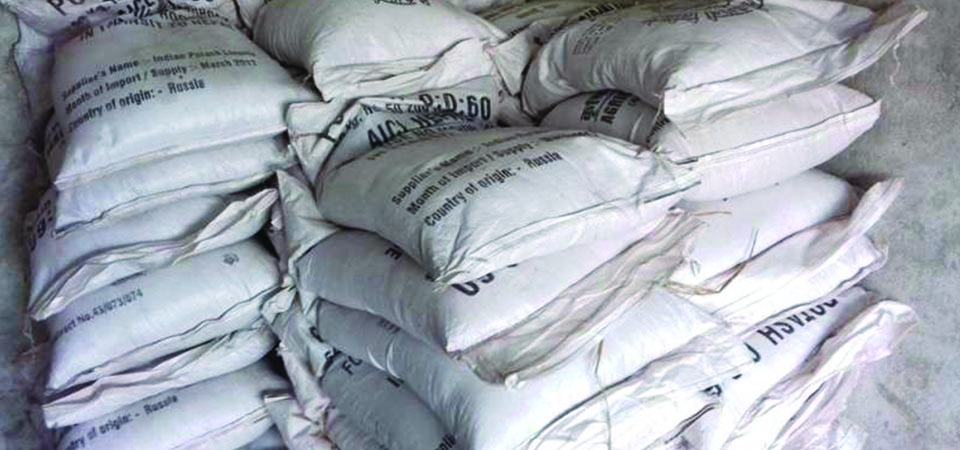Govt gears up to establish fertiliser plant

By Modnath Dhakal
Kathmandu, Jan. 24: Nepal needs about 1.35 million tonnes of chemical fertilisers per year but the continuous crisis has pushed the actual demand down to about 800 thousand tonnes while only 450 thousand tons is imported. Shortage of chemical fertilisers is a recurring crisis in Nepal. The country reels under the acute shortage of the much-needed agricultural input at the time when the farmers need it the most, like during paddy plantation and wheat plantation.
Farmers across the country use about 6 hundred thousand tons of compost manure. Although there is no exact data, hundreds of thousand tons of fertilisers is smuggled to Nepal via India especially during paddy cultivation.
The government spends billions of rupees for grants in imported fertilisers. According to Ministry of Agriculture and Livestock Development, Rs. 10 billion was allocated for the fertiliser grant in the last fiscal year which increased to Rs. 11 billion in the current FY 2020/21.
Amidst this scenario and the haunting experience of fertiliser shortage in the previous season, the government on Wednesday announced to establish a chemical fertiliser factory in the country.
A meeting of Minister for Finance Bishnu Prasad Paudel, Minister for Industry, Commerce and Supplies Lekh Raj Bhatta and Minister for Agriculture and Livestock Padma Kumari Aryal, and secretaries had announced that the process for the establishment of the factory had been initiated.
A Cabinet meeting on 9 November 2020 had formed a committee led by Finance Minister Paudel to conduct preliminary study about the establishment of the fertiliser plant.
In a special interview with The Rising Nepal on Saturday, Minister Aryal said that the meeting had discussed a concept paper to build the fertiliser plant and assigned a team of senior bureaucrats to refine the paper.
The team will submit the paper to the government within two weeks’ period.
The government is considering three options – natural gas-based, coal-based and electricity-based – for the plant. The gas-based plant is the most economic as it could be established at an estimated cost of Rs. 22 billion while the electrolysis method would need about Rs. 157 billion.
IBN suggests gas-based technology
A study conducted by the Investment Board of Nepal (IBN) in 2017 had also suggested to opt for the natural gas-based technology which would require 115 megawatt of electricity and 1197 tonnes of gas per day.
Locations proposed for the establishment of the factory were Dhalkebar in Dhanusha district of Province 2 and Bardghat of Nawalparasi district of Lumbini Province.
Minister Aryal said that the gas-based option is more feasible and cheaper as the gas could be imported from India through a pipeline. Bardghat could be an ideal option for it.
The IBN also said that the electricity-based plant would be much more expensive.
The government is considering to establish the new plant in Public-Private Partnership (PPP) and the plant could be developed within five years.
“When the government facilitates land acquisition, import and installation of the plant, developing the gas pipeline, and the market is immediately available, private sector might have a good opportunity to invest in the plant as per the PPP model,” said Aryal.
According to the IBN, the role of government in the project would be provision of government land, land acquisition, facilitation and project security, facilitating legal approvals/permits, and review and monitoring. Likewise, the private sector’s role will be plan, design, build, finance and operate the facilities during the concession period, collection of revenues from the project and hand over to the government after the concession period expires.
Dr. Shree Ram Ghimire, Spokesperson of the MoALD, said that the IBN report could be the point of departure in terms of establishing a new fertiliser plant.
He said that inputs would be taken from the National Planning Commission as well.
There will be interactions and discussions with the private sector before finalising the construction and operation modality of the plant.
A long-term solution
Nepal is an agrarian country with 65 per cent people involved in agriculture and the sector contributing about 29 per cent to the Gross Domestic Product (GDP) of the country. It is also sector that generates the biggest number of jobs.
“We must work to increase the agricultural productivity and find a long-term solution to the perennial crisis of fertilisers. Establishment of the fertiliser plant is an important step towards it,” Minister Aryal said.
While assuming the post of the Agriculture and Livestock Minister last month, Aryal had announced that fertiliser storage facilities would be established in each province to ensure the timely supply of the much-needed agricultural input.
The Agricultural Inputs Company and Salt Trading Corporation are the agencies responsible for the procurement of fertilisers but they have continuously failed in the timely supply of chemical fertilisers.
Recent News

Do not make expressions casting dout on election: EC
14 Apr, 2022
CM Bhatta says may New Year 2079 BS inspire positive thinking
14 Apr, 2022
Three new cases, 44 recoveries in 24 hours
14 Apr, 2022
689 climbers of 84 teams so far acquire permits for climbing various peaks this spring season
14 Apr, 2022
How the rising cost of living crisis is impacting Nepal
14 Apr, 2022
US military confirms an interstellar meteor collided with Earth
14 Apr, 2022
Valneva Covid vaccine approved for use in UK
14 Apr, 2022
Chair Prachanda highlights need of unity among Maoist, Communist forces
14 Apr, 2022
Ranbir Kapoor and Alia Bhatt: Bollywood toasts star couple on wedding
14 Apr, 2022
President Bhandari confers decorations (Photo Feature)
14 Apr, 2022










